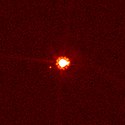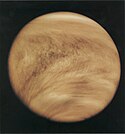Planetarische Diskriminante
Die planetarische Diskriminante μ wurde im Zusammenhang mit der Frage der Planetendefinition von Steven Soter eingeführt. Sie gibt das Verhältnis der Masse eines im Sonnensystem befindlichen Körpers zu der Masse der sonstigen Objekte in seiner Umlaufbahn und deren Umgebung an, sofern es sich dabei nicht um Monde oder resonant umlaufende Himmelskörper handelt.
Die folgende Tabelle enthält die Werte der planetarischen Diskriminante für alle derzeit bekannten Planeten und mehrere Zwergplaneten. Die derzeit acht bekannten Planeten des Sonnensystems nach der Definition der Internationalen Astronomischen Union (IAU) von 2006 haben einen Wert μ größer 100, Zwergplaneten einen Wert kleiner 100.[1]
Des Weiteren ist auch der Stern-Levison-Parameter normiert auf die Erde angegeben. Er ist definiert als . Dabei ist
- die Masse des Objekts
- die Umlaufzeit des Objekts
- die Hubble-Zeit
- Dauer um kleinere Objekte aus dem Bahnbereich zu entfernen
- eine für das jeweilige System typische Konstante[1]
Die Größe dieser Parameter wurde für Beobachtungen von Planeten um fremde Sterne entwickelt und gibt an, wie stark ein Planet seine Umgebung kontrolliert. Für die Erde ist ΛE ca. 150.000.
| Rang | Name | Bild | Planetarische Diskriminante μ | Stern-Levison-P. Λ/ΛE | Masse (in kg) | Objekttyp | Große Halbachse |
|---|---|---|---|---|---|---|---|
| 1 | Erde | 1700000 | 1.00e0 | 5.9736e24 | 3. Planet | 1 AE | |
| 2 | Venus | 1350000 | 1.08e0 | 4.8685e24 | 2. Planet | 0,7230 AE | |
| 3 | Jupiter | 625000 | 8.51e3 | 1.8990e27 | 5. Planet | 5,204 AE | |
| 4 | Saturn | 190000 | 3.08e2 | 5.6846e26 | 6. Planet | 9,582 AE | |
| 5 | Merkur | 91000 | 1.26e-2 | 3.3020e23 | 1. Planet | 0,3871 AE | |
| 6 | Uranus | 29000 | 2.51e0 | 8.6832e25 | 7. Planet | 19,201 AE | |
| 7 | Neptun | 24000 | 1.79e0 | 1.0243e26 | 8. Planet | 30,047 AE | |
| 8 | Mars | 5100 | 6.10e-3 | 6.4185e23 | 4. Planet | 1,524 AE | |
| 9 | Ceres | 0.33 | 8.70e-9 | 9.3500e20 | Zwergplanet | 2,767 AE | |
| 10 | Eris | 0.10 | 3.50e-8 | 1.6600e22 | Zwergplanet | 67,740 AE | |
| 11 | Pluto | 0.07 | 1.95e-8 | 1.2500e22 | Zwergplanet | 39,482 AE |
Weblinks
- Steven Soter: What is a Planet? In: The Astronomical Journal, 16. August 2006, arxiv:astro-ph/0608359
Einzelnachweise
- ↑ a b Steven Soter: What is a planet? In: The Astronomical Journal. Band 132, Nr. 6, 16. August 2006, ISSN 0004-6256, S. 2513–2519, doi:10.1086/508861, arxiv:astro-ph/0608359.
Auf dieser Seite verwendete Medien
Reprocessed Mariner 10 data was used to produce this image of Mercury. The smooth band is an area of which no images were taken.
Obraz Ceres ze zdjęć zrobionych 5 i 6 Maja 2015. Dystans 13 600 km.
Global mosaic of 102 Viking 1 Orbiter images of Mars taken on orbit 1,334, 22 February 1980. The images are projected into point perspective, representing what a viewer would see from a spacecraft at an altitude of 2,500 km. At center is Valles Marineris, over 3000 km long and up to 8 km deep. Note the channels running up (north) from the central and eastern portions of Valles Marineris to the area at upper right, Chryse Planitia. At left are the three Tharsis Montes and to the south is ancient, heavily impacted terrain. (Viking 1 Orbiter, MG07S078-334SP)
Some of the features in this mosaic are annotated in Wikimedia Commons.
„Blue Marble“, die während des Fluges von Apollo 17 zum Mond am 7. Dezember 1972 entstandene Fotoaufnahme von der Erde
This image of Uranus was compiled from images returned Jan. 17, 1986, by the narrow-angle camera of Voyager 2. The spacecraft was 9.1 million kilometers (5.7 million miles) from the planet, several days from closest approach. This picture has been processed to show Uranus as human eyes would see it from the vantage point of the spacecraft. The picture is a composite of images taken through blue, green and orange filters. The darker shadings at the upper right of the disk correspond to the day-night boundary on the planet. Beyond this boundary lies the hidden northern hemisphere of Uranus, which currently remains in total darkness as the planet rotates. The blue-green color results from the absorption of red light by methane gas in Uranus' deep, cold and remarkably clear atmosphere.
Saturn Cassini-Huygens (NASA)
Instrument: Imaging Science Subsystem - Narrow Angle
Saturn's peaceful beauty invites the Cassini spacecraft for a closer look in this natural color view, taken during the spacecraft's approach to the planet. By this point in the approach sequence, Saturn was large enough that two narrow angle camera images were required to capture an end-to-end view of the planet, its delicate rings and several of its icy moons. The composite is made entire from these two images.
Moons visible in this mosaic: Epimetheus (116 kilometers, 72 miles across), Pandora (84 kilometers, 52 miles across) and Mimas (398 kilometers, 247 miles across) at left of Saturn; Prometheus (102 kilometers, 63 miles across), Janus (181 kilometers, 113 miles across) and Enceladus (499 kilometers, 310 miles across) at right of Saturn.
The images were taken on May 7, 2004 from a distance of 28.2 million kilometers (17.6 million miles) from Saturn. The image scale is 169 kilometers (105 miles) per pixel. Moons in the image have been brightened for visibility.
The Cassini-Huygens mission is a cooperative project of NASA, the European Space Agency and the Italian Space Agency. The Jet Propulsion Laboratory, a division of the California Institute of Technology in Pasadena, manages the Cassini-Huygens mission for NASA's Office of Space Science, Washington, D.C. The Cassini orbiter and its two onboard cameras, were designed, developed and assembled at JPL. The imaging team is based at the Space Science Institute, Boulder, Colo.
For more information, about the Cassini-Huygens mission visit, http://saturn.jpl.nasa.gov and the Cassini imaging team home page, http://ciclops.org.Original Caption Released with Image: This processed color image of Jupiter was produced in 1990 by the U.S. Geological Survey from a Voyager 2 image captured in 1979. The colors have been enhanced to bring out detail. Zones of light-colored, ascending clouds alternate with bands of dark, descending clouds. The clouds travel around the planet in alternating eastward and westward belts at speeds of up to 540 kilometers per hour. Tremendous storms as big as Earthly continents surge around the planet. The Great Red Spot (oval shape toward the lower-left) is an enormous anticyclonic storm that drifts along its belt, eventually circling the entire planet.
A mosaic of Pluto images taken by the LORRI instruments aboard the New Horizons spacecraft, coloured by data from the Ralph instrument.
ORIGINAL FILE DESCRIPTION:
July 24, 2015
Global Mosaic of Pluto in True Color
Pluto
Four images from New Horizons’ Long Range Reconnaissance Imager (LORRI) were combined with color data from the Ralph instrument to create this sharper global view of Pluto. (The lower right edge of Pluto in this view currently lacks high-resolution color coverage.) The images, taken when the spacecraft was 280,000 miles (450,000 kilometers) away from Pluto, show features as small as 1.4 miles (2.2 kilometers). That’s twice the resolution of the single-image view captured on July 13 and revealed at the approximate time of New Horizons’ July 14 closest approach.Ultraviolet image of Venus's clouds as seen by the Pioneer Venus Orbiter (February 26, 1979). The immense C- or Y-shaped features which are visible only in these wavelengths are individually short lived, but reform often enough to be considered a permanent feature of Venus's clouds. The mechanism by which Venus's clouds absorb ultraviolet is not well understood.





















